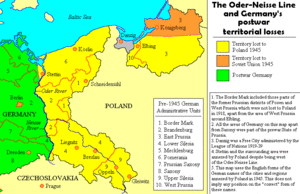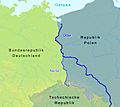Oder-Neisse line facts for kids
The Oder-Neisse line (named after the Oder and Neisse rivers) is the border between Germany and Poland since the end of the Second World War. As a result of the defeat Germany lost another huge part of its territory to Poland after it already had to cede the former Prussian provinces of Posen and Westpreußen as well as parts of upper Silesia to the newly founded Polish state after the First World War in 1919.
The population of the eastern German provinces as well as the German minority population in what was Poland before the Second World War (12 million) either fled before the Russian army to central and western Germany or were later driven out of their homeland by force of the Polish militia who entered immediately after the Russian army.
As Poland annexed the German provinces and deported the native population, Polish people occupied those provinces and took over land and property of the expatriated Germans. About 1.5 million of the new inhabitants had been driven out of their own homeland in eastern Poland/Western Ukraine, Belarus, as the U.S.S.R. was not willing to give back that part of 1922-1939 Poland which it had annexed in 1939.
Images for kids
-
Oder Lagoon area with border on western bank of the Oder, city of Szczecin to the south.
-
US Department of State Demographics map from 10 January 1945 Germany – Poland Proposed Territorial Changes, based in part on German prewar population census. Was used for border discussions at the Potsdam conference later in 1945.
-
1951 East German stamp commemorative of the Treaty of Zgorzelec establishing the Oder–Neisse line as a "border of peace", featuring the presidents Wilhelm Pieck (GDR) and Bolesław Bierut (Poland)
-
The Lusatian Neisse dividing German Görlitz (right) from Polish Zgorzelec (left); formerly both constituted the city of Görlitz.
See also
 In Spanish: Línea Óder-Neisse para niños
In Spanish: Línea Óder-Neisse para niños














